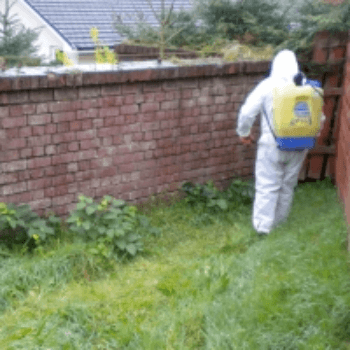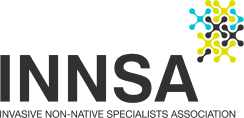
INNSA Standard
Herbicide Spraying of Japanese Knotweed
Spraying of chemical herbicide is a commonly used and cost-effective means of Japanese knotweed control.
- All operatives carrying out spraying works will hold (or be directly supervised by someone holding) a valid certificate of competence (e.g. NPTC PA1*), as well as the r elevant award relating to the equipment being used (e.g. NPTC PA6A*)
- INNSA Contractor Members offering invasive weed treatment should provide additional continued training to all site operatives. This training should provide specific information and techniques regarding all non-native invasive species which the site operatives will be required to treat.
- Where chemical application works are carried out in or near to water, a relevant award (e.g. PA6INJ or PA6AW*) must be held by a supervising member of the site team.
- Operations being carried out near water should apply for permission and comply with Environment Agency (or the relevant local agency’s) water quality management requirements.
- Herbicide mixing and application works should always be carried out using appropriate PPE, specific to the task in hand.
- Chemical application works should be carried out with a relevant policy in place to minimise the risks of cross-contamination, protect the environment and minimise any risk to water.
- Companies should be forthcoming with customers about the risks and limitations of herbicide treatments and timescales for treatment.
- Contractors should always provide a written method statement, risk-assessment and COSHH assessment for all herbicide application works that are undertaken.
- Contractors should follow all statutory instructions, including the recommended dosage rates as specified on the product label and any relevant manufacturers’ guidelines.
- Companies should implement measures to avoid applying chemical to non-target species, taking account of spray drift, weather conditions and the variety of application methods available.
- Companies should, where possible and where appropriate, obtain written permission from neighbouring landowners, where treatment may pose a risk to non-target species on their land.
- When offering chemical eradication of Japanese knotweed, companies should recommend treatment plans as standard, which include a minimum number of sprays, over a minimum period of time.
- Companies should at all times maintain an awareness of current pesticide regulations and laws appropriate to their area(s) of operation and ensure all employees and sub-contractors are regularly updated, preferably through CPD accreditation.
- Customers should be made aware that irrespective of the herbicide application method (foliar/stem injection/leaf wipe), treatment areas should be treated as contaminated even after herbicide application.
- Ground disturbance or excavation work within the contaminated areas and buffer zones will need to contractor’s consent prior to works commencing and may require additional remediation.
- Single applications of chemical may be offered, but should not be recommended as a long-term solution.
*Further details available at https://www.nptc.org.uk/qualificationdefault.aspx
